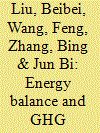|
|
|
Sort Order |
|
|
|
Items / Page
|
|
|
|
|
|
|
| Srl | Item |
| 1 |
ID:
103460


|
|
|
|
|
| Publication |
2011.
|
| Summary/Abstract |
China is the world's second-largest energy producer and consumer, so that it is very necessary to analyze China's energy situation for saving energy consumption and reducing GHG emission. Energy flow chart is taken as a useful tool for sorting out and displaying energy statistics data. Energy statistics data is the premise and foundation for analyzing energy situation. However, there exit many differences between China and foreign energy balance. Based on the international criterion of energy balance and some advices given by related experts, the author properly adjusts China's energy balance. And the purpose of this paper is to draft China's energy flow chart for 2007, which is used to study the characteristics of energy production and consumption in China. We find that: (1) coal is the main energy in China, which accounted for 73.2% of total energy supply in 2007; (2) thermal power accounted for 83.2% of the total electricity supply, and 78.43% thermal power was based on coal; (3) in 2007, the secondary industrial sector consumed about 69.93% of energy; (4) China's energy utilization efficiency was about 33.23% in 2007.
|
|
|
|
|
|
|
|
|
|
|
|
|
|
|
|
| 2 |
ID:
107633


|
|
|
|
|
| Publication |
2011.
|
| Summary/Abstract |
As with any other bioenergy product, bioethanol production requires fossil fuel inputs; hence the alleged benefits of energy security and carbon mitigation depend on the extent to which these inputs are capable of drawing a substantive bioenergetic yield. Brazilian ethanol, made out of sugarcane, has been reported as the most efficient gasoline substitute that is commercially available nowadays. For that reason it has been the object of several analyses on the energetics, i.e. energy balances. These studies surprisingly vary widely according with the scholar approach and are not fully comparable among them due to divergences in the assessment method.
This paper standardises results of the four most prominent authors in the field, establishing a point of comparison and drawing some light on the energetics studies on biofuels. The main result is shown in Table 5, which homogenises the outcomes for referred studies in terms of unit of assessment in the energy input analysis. Subsequently, this information is also charted (Fig. 2) explaining the source of divergence among authors.
This work ends with a short reference and comparison to some energy balance studies carried out on feedstocks of diverse nature, highlighting the potential that sugarcane-based bioethanol represents nowadays.
|
|
|
|
|
|
|
|
|
|
|
|
|
|
|
|
| 3 |
ID:
121279


|
|
|
|
|
| Publication |
2013.
|
| Summary/Abstract |
Cassava-based fuel ethanol (CFE) is playing an increasingly important role in renewable transportation energy in the Guangxi Province in China. Previous studies have evaluated the energy and greenhouse gas (GHG) performance of CFE, but they have largely overlooked the influences of different agricultural planting modes. In this study, five scenarios related to cassava planting modes were selected to evaluate the lifecycle energy balance and GHG emissions of the CFE system. The results show that, although all the five CFE scenarios show positive net energy values (NEV) and GHG emissions savings compared with the conventional gasoline, the planting modes have significant impacts on their energy and GHG performance. Modes that are considered intensive (i.e. high fertilizer use intensity and highly mechanized harvesting) generally show poorer performance than the extensive ones, primarily because of the intensive energy consumption and GHG emissions during nitrogen fertilizer production, the N2O emission of nitrogen fertilizer use, and higher yield loss rate caused by mechanized harvesting. This study shows that it is important to evaluate the planting modes when producing bioethanol in order to gain an understanding of the life-cycle energy use and GHG performance.
|
|
|
|
|
|
|
|
|
|
|
|
|
|
|
|
| 4 |
ID:
042641


|
|
|
|
|
| Publication |
New York, Praeger Publishers, 1974.
|
| Description |
xv,277p
|
| Series |
Praeger special studies in international economics and developments
|
| Standard Number |
0275089304
|
|
|
|
|
|
|
|
|
|
|
|
Copies: C:1/I:0,R:0,Q:0
Circulation
| Accession# | Call# | Current Location | Status | Policy | Location |
| 015379 | 333.79047/ELL 015379 | Main | On Shelf | General | |
|
|
|
|
|
|
|
|
|